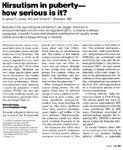Hirsutism in puberty: what's new since 1985
The ninth in a year-long series of commentary reviewing topics published in Contemporary Pediatrics 25 years ago. This month's article reviews the causes and management of hirsutism in adolescent girls.

Hirsutism is quite distinct from hypertrichosis, or excessive vellus (short, fine) hair found on arms and legs that results from heredity or medications. The causes of hirsutism in adolescents have not changed in 25 years, and most commonly include polycystic ovary syndrome (PCOS) and idiopathic hirsutism.2
Uncommon causes include more serious androgen-excess disorders resulting in virilization, which is hirsutism plus other signs of masculinization such as clitorimegaly, deepening of the voice, temporal balding, breast atrophy or loss of female body contour.

Pathogenesis and evaluation
Hirsutism can occur during adolescence, when androgen production from both the adrenal gland and ovary increases with puberty. Vellus hair in androgen-sensitive areas develops into terminal hair follicles or sebaceous glands, resulting in the normal development of axillary and pubic hair as well as increased oiliness on the face. Increased sensitivity to or production of androgens can result in hirsutism, acne, or both. More significant increases in androgens can lead to oligomenorrhea, amenorrhea, or virilization.
The principal androgens are testosterone, androstenedione and dehydroepiandrosterone sulfate (DHEAS). About 50% of testosterone production comes from the adrenal gland, and 50% from the ovary. DHEAS is produced exclusively in the adrenal gland, while androstenedione is converted to testosterone in both the adrenal gland and ovary. Testosterone circulates bound to its protein carrier, sex-hormone binding globulin (SHBG), which is synthesized in the liver. Estrogen increases, while testosterone and insulin resistance decrease SHBG production. The unbound fraction or "free" testosterone is the biologically active form, and represents about 1% of the total testosterone in most women. Thus the amount of testosterone free to bind and activate the androgen receptor, as well as total androgen production and androgen receptor sensitivity, together determine the degree of hirsutism.
The causes of hirsutism can be divided into three major groups: idiopathic, adrenal, and ovarian. Idiopathic hirsutism is the cause in about half of all females complaining of mild hirsutism. They have normal androgen levels and no other signs of hyperandrogenism, such as irregular menses. These girls often have a family history of hirsutism, but not infertility or any adrenal or ovarian problems. Idiopathic hirsutism is believed to result from an increased sensitivity of the androgen receptor to normal androgen levels. These patients do not need any laboratory evaluation, and can be treated with cosmetic hair removal or medications that inhibit hair growth by blocking either the androgen receptor (spironolactone) or an enzyme required for hair follicle growth (eflornithine HCl).
Adrenal etiologies are very uncommon, including non-classical congenital adrenal hyperplasia (CAH) and tumors, and present with clear elevations in androgens. CAH is associated with moderate to severe hirsutism and often other signs of hyperandrogenism, eg, growth acceleration and pubic hair development before age 8, severe cystic acne, clitorimegaly, amenorrhea, or irregular menses.3 Adrenal tumors are rare in childhood and adolescence, but present with other concerning signs, including rapidly advancing virilization and often evidence of excess cortisol, such as truncal obesity and hypertension.
Ovarian causes of hirsutism are usually due to PCOS and are associated with menstrual irregularities and normal to mildly elevated androgen levels.4 Other etiologies include a number of ovarian tumors, which present with sudden onset and rapid progression of virilization due to very elevated androgen levels.
Evaluation of hirsutism should reflect the degree of hyperandrogenism suspected from the history and physical examination. Girls with mild hirsutism, normal menstrual periods and no other signs of virilization have idiopathic hirsutism, and therefore do not require measurement of androgen levels. Girls presenting with mild to moderate hirsutism associated with menstrual irregularities but no other signs of virilization most likely have PCOS. Other common features are obesity and evidence of insulin resistance, such as acanthosis nigricans.4 However, conditions that need to be excluded include non-classical CAH. Other conditions that can present with mild hirsutism and menstrual dysfunction will have other distinguishing features, for example, Cushing's syndrome (striae, hypertension), hyperprolactinemia (galactorrhea), and primary hypothyroidism (thyromegaly, fatigue, constipation).
Prudent laboratory evaluation for suspicion of PCOS without other features includes LH, FSH, total and/or free testosterone, and fasting 17-hydroxyprogesterone (17-OHP) to rule out mild non-classical CAH. Results consistent with PCOS are likely to demonstrate an increased LH to FSH ratio, normal 17-OHP and normal or mildly elevated free or total testosterone. Be advised that plasma total testosterone assays are highly variable; therefore measurement of plasma free testosterone is more sensitive than a total testosterone in detecting androgen excess.
Moderate to severe hirsutism with menstrual dysfunction or any evidence of virilization requires a more extensive evaluation to rule out uncommon adrenal and ovarian causes of hyperandrogenism. The initial lab evaluation should include DHEAS and a fasting 17-OHP for adrenal sources and total and free testosterone for ovarian sources. DHEAS levels above 800 ug/dL suggest an adrenal tumor and 17-OHP levels above 200 ng/dL suggest non-classical CAH. In the past, elevated DHEAS levels were considered to be the most sensitive marker of a virilizing adrenal tumor, but recent studies demonstrate that testosterone is a better marker.5 Testosterone levels exceeding 200 ng/dL may indicate an adrenal or ovarian tumor. Significantly elevated DHEAS or testosterone levels are an indication for imaging studies, and unlike 25 years ago when the preferred imaging was computer tomography, ultrasonography is the now the first choice both for convenience and sensitivity.6
Having "the talk" with teen patients
June 17th 2022A visit with a pediatric clinician is an ideal time to ensure that a teenager knows the correct information, has the opportunity to make certain contraceptive choices, and instill the knowledge that the pediatric office is a safe place to come for help.
Recognize & Refer: Hemangiomas in pediatrics
July 17th 2019Contemporary Pediatrics sits down exclusively with Sheila Fallon Friedlander, MD, a professor dermatology and pediatrics, to discuss the one key condition for which she believes community pediatricians should be especially aware-hemangiomas.